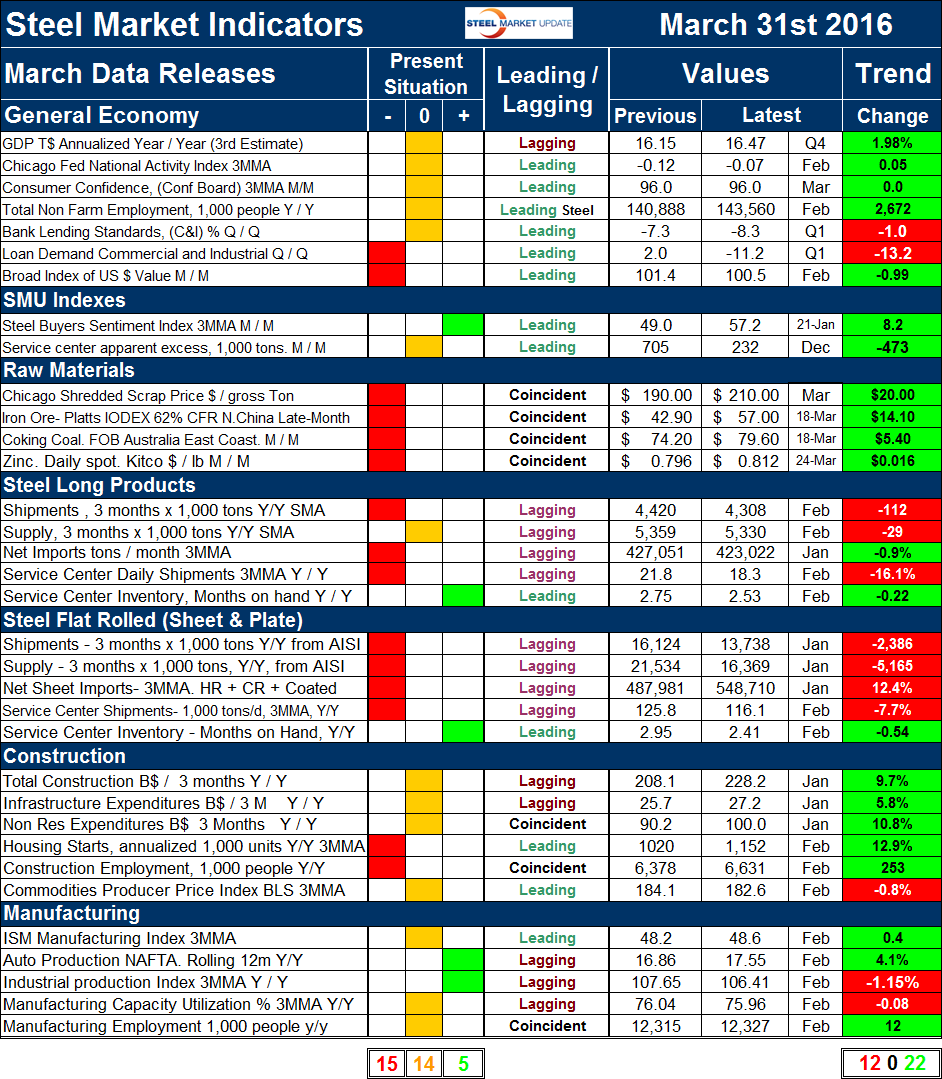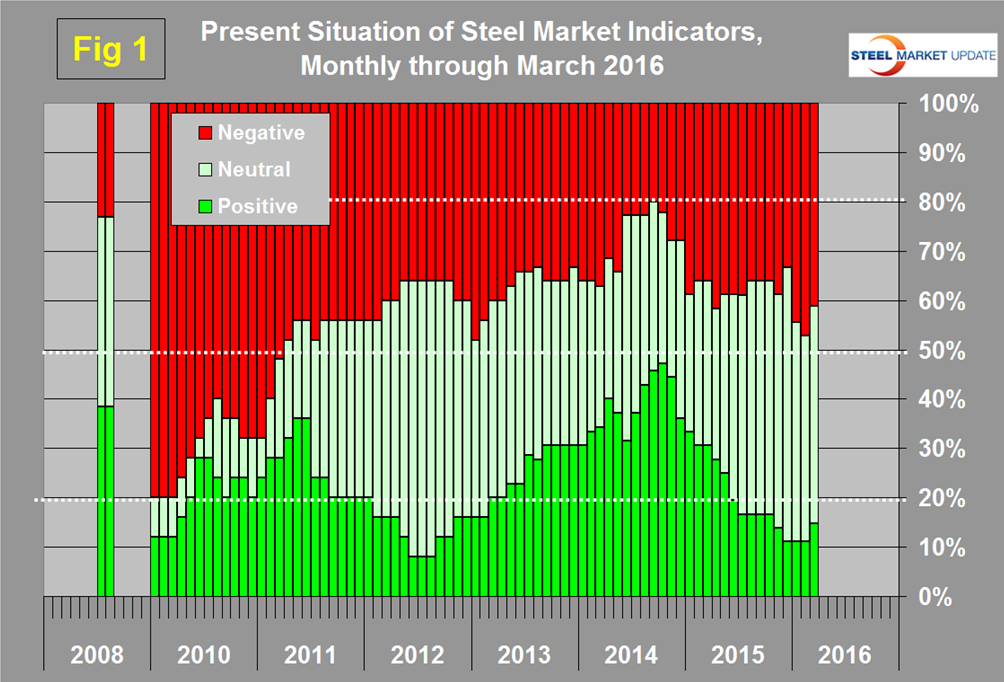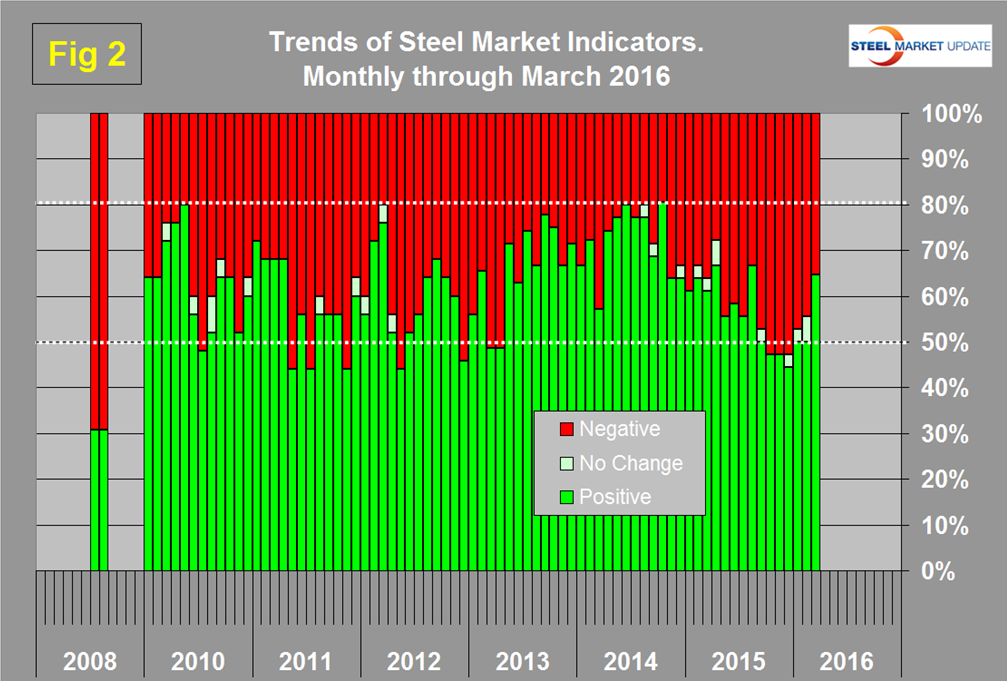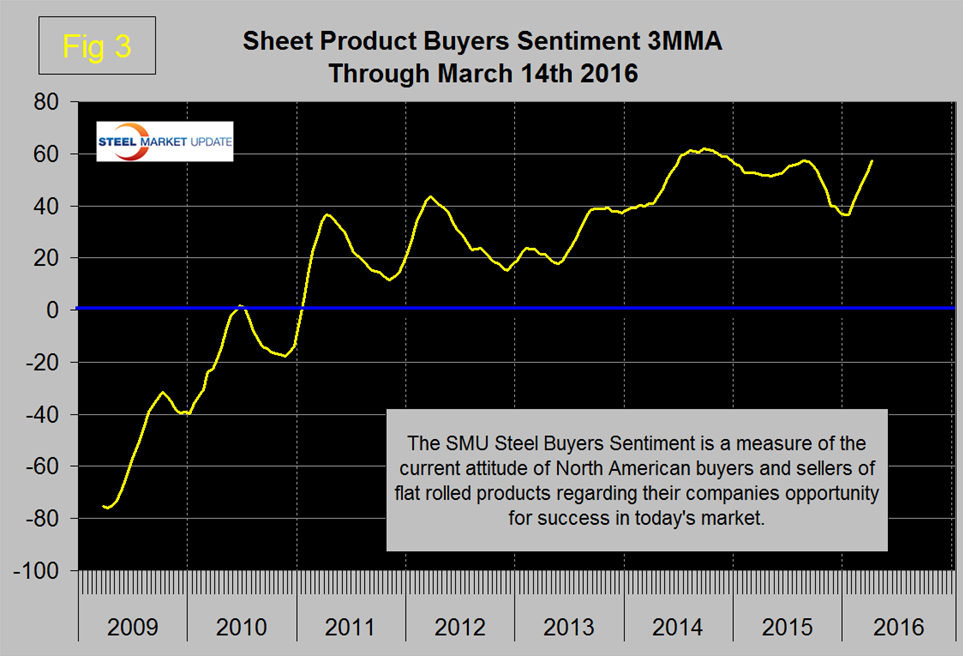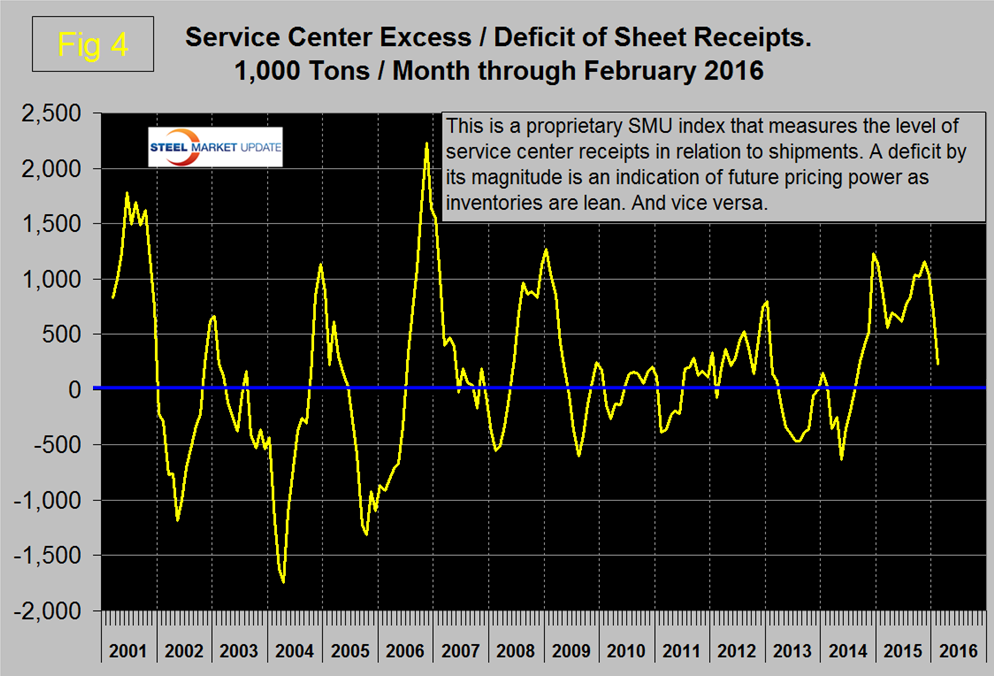Market Data

April 1, 2016
Key Market Indicators - March 31, 2016
Written by Peter Wright
An explanation of the Key Indicators concept is given at the end of this piece for those readers who are unfamiliar with it.
![]() The total number of indicators considered in this analysis is currently 34.
The total number of indicators considered in this analysis is currently 34.
Please refer to Table 1 for the view of the present situation and the quantitative measure of trends. Readers should regard the color codes in the present situation column as a quick look at the current market condition. The “Trend” columns of Table 1, are also color coded to give a quick visual appreciation of the direction in which the market is headed. All data included in this table was released in March, the month or specific date to which the data refers is shown in the second column from the far right and all data is the latest available as of March 31st.
Present Situation
There was a decrease of one negatives since we last published this review on February 28th and an increase of one positive. We currently regard 5 of the 34 indicators to be positive, 14 to be neutral and 15 to be negative on a historical basis. Changes in the last month were as follows; service center apparent excess declined sharply as shown in the graph below and was revised from negative to neutral. Service center inventory of flat rolled products was revised from neutral to positive as months on hand declined to 2.41. There were no changes to the present situation of construction and manufacturing indicators. Figure 1 shows the change in our assessment of the present situation since January 2010 on a percentage basis.
The number of indicators classified as positive peaked at 47.2 percent in October 2014 and steadily declined to 11.1 percent in the three months prior to this update. In March the positives rose to 14.7 percent. Through the course of 2015 there was not much change in the number of indicators that we considered to be historically negative, what happened was that the decline in the positive indicators occurred as a shift to neutral. The present situation of the general economy with the exception of loan demand and the value of the US $ is OK. Not great and not unsatisfactory by historical standards. Last week’s update of the growth of GDP in Q4 improved from the first estimate of 0.69 percent to 1.0 percent in the second and to 1.4 percent in the third estimate. All the raw materials prices currently have a negative present situation. The present situation of the long products market is slightly better than for flat rolled. In our analysis here, shipments and supply are based on SMA data for long products and AISI for flat products. In summary a quick visual appraisal of the present situation shows that the general economy is basically neutral. Steelmaking raw materials are historically weak through March’s data. The two steel sectors are similar. Construction continues to be weak to neutral and manufacturing continues to be neutral to strong. No indicators are currently rated positive in the construction category and none of the manufacturing indicators on a present situation basis are currently negative.
Trends
The proportion of indicators trending positive through March 31st was 64.7 percent with 35.3 percent trending negative. This was a tremendous surge in positives since our last update when only 50 percent were headed in the right direction. Most values in the trends columns are three month moving averages (3MMA) to smooth out what can be very erratic monthly data. Figure 2 shows the trend of the trends.
There was a steady deterioration from the middle of 2014 through 2015. At the end of 2015 the proportion trending positive fell below 50 percent for the first time since March and April 2013. In the January and February data the situation improved and then the positives surged by 14.7 percent in March. In October 2014 the proportion trending positive was 80.6 percent which coincided with the highest month of total steel supply since the recession. Figure 2 shows the pre-recession situation at the far left of the chart. In August 2008 over 2/3 (69.2 percent) of our indicators were trending negative and the steel market crashed in September of that year.
Changes in the individual sectors are described below (please note in most cases this is not March data but data that was released in March through the 31st for previous months).
In the general economy, the direction of the Conference Board consumer confidence index reversed course and became slightly positive on a 3MMA basis and the broad index value of the US $ declined. We regard a declining dollar as positive because of the effect on net imports. Both of the Steel Market Update proprietary indices reversed direction and became positive in our January update. They continued to trend positive in February and March. The SMU buyer’s sentiment index improved from 36.5 in December to 41.7 in January, to 49.0 in February and to 57.2 in mid-March as shown in Figure 3.
The index continues to be at a historically strong level. The calculation of service center excess inventory of sheet products declined in December, January and February with an accelerating trend. A high excess is indicative of low pricing power therefore we regard this trend as positive (Figure 4).
In the raw materials price section all are now trending positive. The price of Chicago shredded which had been unchanged in February rose by $20 in March. The price of iron ore surged in March then settled back to a gain of $14.10 on March 18th.
There were no trend changes in the indicators for either long or flat products or for construction. In manufacturing the ISM index reversed direction and trended positive for the first time since our August 30th update.
Trends in the March data are very encouraging. This series is relatively stable therefore if the positive trend is confirmed in April there will be a believable indication that a positive shift in the market is occurring.
We believe a continued examination of both the present situation and direction is a valuable tool for corporate business planning.
Explanation: The point of this analysis is to give both a quick visual appreciation of the market situation and a detailed description for those who want to dig deeper. It describes where we are now and the direction in which the market is headed and is designed to give a snapshot of the market on a specific date. The chart is stacked vertically to separate the primary indicators of the general economy, of proprietary Steel Market Update indices, of raw material prices, of both flat rolled and long product market indicators and finally of construction and manufacturing indicators. The indicators are classified as leading, coincident or lagging as shown in the third column.
Columns in the chart are designed to differentiate between where the market is today and the direction in which it is headed. Our evaluation of the present situation is subjectively based on our opinion of the historical value of each indicator. There is nothing subjective about the trends section which provides the latest facts available on the date of publication. It is quite possible for the present situation to be predominantly red and trends to be predominantly green and vice versa depending on the overall situation and direction of the market. The present situation is sub-divided into, below the historical norm (-) (OK), and above the historical norm (+). The “Values” section of the chart is a quantitative definition of the market’s direction. In most cases values are three month moving averages to eliminate noise. In cases where seasonality is an issue, the evaluation of market direction is made on a year over year comparison to eliminate this effect. Where seasonality is not an issue concurrent periods are compared. The date of the latest data is identified in the third values column. Values will always be current as of the date of publication. Finally the far right column quantifies the trend as a percentage or numerical changith color code classification to indicate positive or negative direction.



